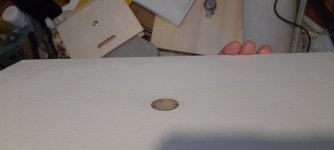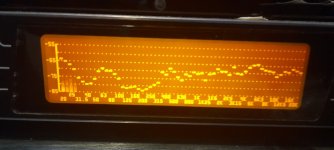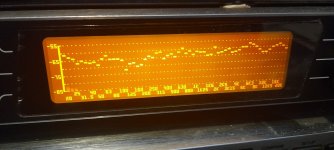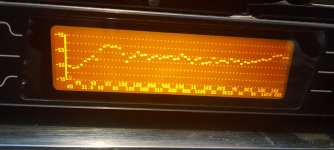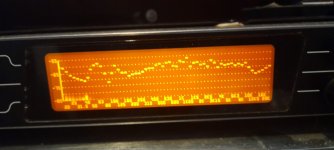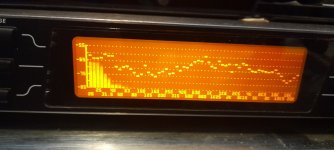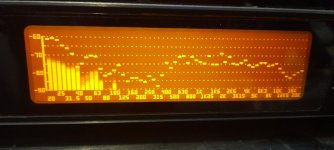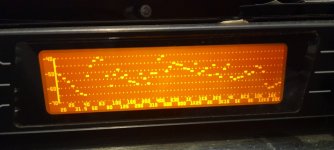He certainly doesn't like domes.This article has some interesting details/views on dome tweeters:
https://www.thebroadcastbridge.com/content/entry/9407/loudspeaker-technology-part-10-tweeters
EucyDome Episode 3:
You will need these (or equal):
View attachment 1084752View attachment 1084753
Eucy
I agree with most of what he says about the problems with domes, but a lot of people like them.
All I can say is that some domes sound good and some don't.
But then I could say the same for all types of tweeters.
The area in-between the coils is always going to be a problem, it's trying to find a compromise that sort of works ?
And keeping well away from cavity, and other resonances.
Cones sometimes use a phase plug in the centre of the coil.
Or a fine mesh and also various cover materials.
The problem with a cone on the panel, or just the surface of the panel, is that it is operating full range.
So that these resonances can be a problem, that you cannot XO away.
Steve.
The more panel materials tested the better.As fate decrees, I happen to have a smallish sample of such a panel - not 4mm thick but about 2-2.5mm ish - used for caravan panels it seems - not sure - was given to me by a friend who obtained some from a caravan builders junk pile - thought I'd try and test it some time - it rings a bit om a tap test and it's relatively heavy so not sure - will take some oof to drive it I reckon
Eucy
The very thin aluminium ply panels I had , which were 2 sheets glued together with spray mount, were very similar to my small card and veneer panels.
Maybe I should have tried a smaller size similar to these panels.
This panel did not ring, and had a very dead sound.
Maybe it was too big ?
I did look for it , but I must have thrown it away 😱
But I do have a lot of this material in my shed, and I think I still have some spray mount.
Steve.
I was more thinking of the fact that he doesn't like (hates) fabric domes 😄😜He certainly doesn't like domes.
I agree with most of what he says about the problems with domes, but a lot of people like them.
All I can say is that some domes sound good and some don't.
But then I could say the same for all types of tweeters.
The area in-between the coils is always going to be a problem, it's trying to find a compromise that sort of works ?
And keeping well away from cavity, and other resonances.
Cones sometimes use a phase plug in the centre of the coil.
Or a fine mesh and also various cover materials.
The problem with a cone on the panel, or just the surface of the panel, is that it is operating full range.
So that these resonances can be a problem, that you cannot XO away.
Steve.
And the matter of the dome shape not contributing to radiation. He also doesn't refer to the contribution of the dome shape for rigidity and breakup control.
Eucy
Hi dreamth.This guy is using Dayton drivers.Are there even better drivers for these loudspeakers?
If you look back a few posts you'll see reference to some older posts addressing this question.
Cheers
Eucy
+ @Alaska129As fate decrees, I happen to have a smallish sample of such a panel - not 4mm thick but about 2-2.5mm ish - used for caravan panels it seems - not sure - was given to me by a friend who obtained some from a caravan builders junk pile - thought I'd try and test it some time - it rings a bit om a tap test and it's relatively heavy so not sure - will take some oof to drive it I reckon
Eucy
My thoughts are more on the use of aluminum flashing (some 1/10mm thick) locally at the exciter interface area.
Yes it is a little confusing, as it is well known that hard materials like aluminium and others tend to have a hard sound sometimes?I was more thinking of the fact that he doesn't like (hates) fabric domes 😄😜
And the matter of the dome shape not contributing to radiation. He also doesn't refer to the contribution of the dome shape for rigidity and breakup control.
Eucy
But my dome is not intended to have a high output, which it can if the right materials are used, but to help prevent the problems he mentions within the coil area.
He does not even mention the cavity resonance , just the reflection from the magnet.
The proplex seems to be one of the materials that damps or rejects these problems.
Other materials can tend to exaggerate these problems.
Steve.
I had a look at the aluminium sheets in my shed , I measured two sheets together and it was still just below 0.5 mm , so with spray mount, the panel would be about 0.5 thick.
This could be a candidate for a 6x9inch panel ?
On the large sheet I don't think there was a lot of dml going on, it was more of a lossy bending wave ? With the main output from the central area.
Steve.
This could be a candidate for a 6x9inch panel ?
On the large sheet I don't think there was a lot of dml going on, it was more of a lossy bending wave ? With the main output from the central area.
Steve.
EucyDome Episode 4
You will need to accurately measure your exciter voice coil diameter. Some exciters have quite wide mounting flanges so try and discern the actual bobbin diameter. Usually the specs will tell you the diameter but check anyway.
Then you need to make an accurate male template to the coil diameter from cardboard or other object matching the required diameter.
You will also need to make a female paper template cutout approx 2mm bigger in diameter than the coil with axes marked... The easiest way is to fold an A4 piece of paper in halves both ways, ink in the fold lines, scribe the circle and cut
Like this:
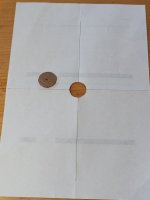
Eucy
You will need to accurately measure your exciter voice coil diameter. Some exciters have quite wide mounting flanges so try and discern the actual bobbin diameter. Usually the specs will tell you the diameter but check anyway.
Then you need to make an accurate male template to the coil diameter from cardboard or other object matching the required diameter.
You will also need to make a female paper template cutout approx 2mm bigger in diameter than the coil with axes marked... The easiest way is to fold an A4 piece of paper in halves both ways, ink in the fold lines, scribe the circle and cut
Like this:

Eucy
Thank you Toddincabo.Typical Ben finished his hybrid build:
The link to TypicalBen web site.
600x400mm 3mm thick acrylic with printed pictures
Mounting method : grommet at the corners + side foam
Finally dug out the laptop with measurements of the panels for the PA system.
In the rush I had not labelled them too well, but I think this is the correct responses.
Blue is pre-eq and red after.
I think I ignored the very large swings in the mids, since they where sounding really good with some EQ and I was in a hurry, but looking at the curves now it is actually nice to see what a disaster it is pre-eq, considering it still sounds really great 🙂
It means there should be plenty of room for improvement when tweaking them to even out the response in 250-600Hz region. I'm hoping I can get decent results by modifying the suspension more, which is very easy to do.

In the rush I had not labelled them too well, but I think this is the correct responses.
Blue is pre-eq and red after.
I think I ignored the very large swings in the mids, since they where sounding really good with some EQ and I was in a hurry, but looking at the curves now it is actually nice to see what a disaster it is pre-eq, considering it still sounds really great 🙂
It means there should be plenty of room for improvement when tweaking them to even out the response in 250-600Hz region. I'm hoping I can get decent results by modifying the suspension more, which is very easy to do.
Thank you Leob for those additional information.Finally dug out the laptop with measurements of the panels for the PA system.
In the rush I had not labelled them too well, but I think this is the correct responses.
Blue is pre-eq and red after.
I think I ignored the very large swings in the mids, since they where sounding really good with some EQ and I was in a hurry, but looking at the curves now it is actually nice to see what a disaster it is pre-eq, considering it still sounds really great 🙂
It means there should be plenty of room for improvement when tweaking them to even out the response in 250-600Hz region. I'm hoping I can get decent results by modifying the suspension more, which is very easy to do.
View attachment 1085679
The possibibility to EQ DML is really an interesting property of those speakers.
About the suspension, there are so many possibilities... which way to take? Why not known if the EQ can do the job?
It would be interesting to see the FR with only one exciter working to see the role of the network of the four exciters
Christian
Yes, they do respond very well to EQ, I think better than normal speakers.
But I do think that region will sound better if I can distribute the modes to avoid a 20dB swing in less than an octave :\
But I do think that region will sound better if I can distribute the modes to avoid a 20dB swing in less than an octave :\
Leob.
Where was your microphone for these measurements?
The higher response below 1k could be from the mutual coupling of the 4 exciters.
Which is handy for you as this will give you more power handling when EQ'd.
For the higher frequencies 2 or more exciters are just as likely to be fighting each other , than in mutual coupling.
So you do not get the efficiency you would normally hope for.
But I personally like a bit of a sloping response in my room, this seems to balance the sound well when blending in the subs.
Steve.
Where was your microphone for these measurements?
The higher response below 1k could be from the mutual coupling of the 4 exciters.
Which is handy for you as this will give you more power handling when EQ'd.
For the higher frequencies 2 or more exciters are just as likely to be fighting each other , than in mutual coupling.
So you do not get the efficiency you would normally hope for.
But I personally like a bit of a sloping response in my room, this seems to balance the sound well when blending in the subs.
Steve.
I took measurements approx 1m away, running 4 panels at the same time.Leob.
Where was your microphone for these measurements?
The higher response below 1k could be from the mutual coupling of the 4 exciters.
Which is handy for you as this will give you more power handling when EQ'd.
For the higher frequencies 2 or more exciters are just as likely to be fighting each other , than in mutual coupling.
So you do not get the efficiency you would normally hope for.
But I personally like a bit of a sloping response in my room, this seems to balance the sound well when blending in the subs.
Steve.
Unfortunately I never really did a comparison of the same panel with different number of exciters, so only have my general subjective impressions. But at least I haven't noticed any trend of less sensitivity or more uneven FR when using 4 exciters, so probably the difference is quite minor. In general my impression is that I get better results with 4 exciters.
I do like a warm sound, but when listening on low levels they could do with a bit of treble lift as they are now. However when blasting at full level for many hours I think the current slope is good and sounds clear enough but very non fatiguing despite very high SPL.
I just found a 14x20inch 3mm ply panel behind the wood burning stove, it was put there to stop drafts and dirt coming down the chimney.
It still had the exciter attached to it !
So I hooked it up and measured it.
I had already painted it in white vinyl paint.
It is still coated in cobwebs and dust.
First pic.
6inches.
second pic.
1m
Third pic
3m with room suckout in the low end.
Steve.
It still had the exciter attached to it !
So I hooked it up and measured it.
I had already painted it in white vinyl paint.
It is still coated in cobwebs and dust.
First pic.
6inches.
second pic.
1m
Third pic
3m with room suckout in the low end.
Steve.
Attachments
Leob.
Some pics of my 2ft grey 20mm eps.
1.
At 12inches
2.
At 1m.
3.
At 3m
And 4.
Playing large drums and percussion, peak hold.
The room suckout is a big problem for this panel ,but it does still have a strong output down to 40hz.
Steve.
Some pics of my 2ft grey 20mm eps.
1.
At 12inches
2.
At 1m.
3.
At 3m
And 4.
Playing large drums and percussion, peak hold.
The room suckout is a big problem for this panel ,but it does still have a strong output down to 40hz.
Steve.
Attachments
I find that the suspension reduces the low end a lot, and my goal has been to get reasonably flat response down to 100Hz, which is an xo where most subs work well. I did have even heavier suspension earlier, but that made the panels even more focused around 200-300Hz and limited the response below that.
- Home
- Loudspeakers
- Full Range
- A Study of DMLs as a Full Range Speaker
